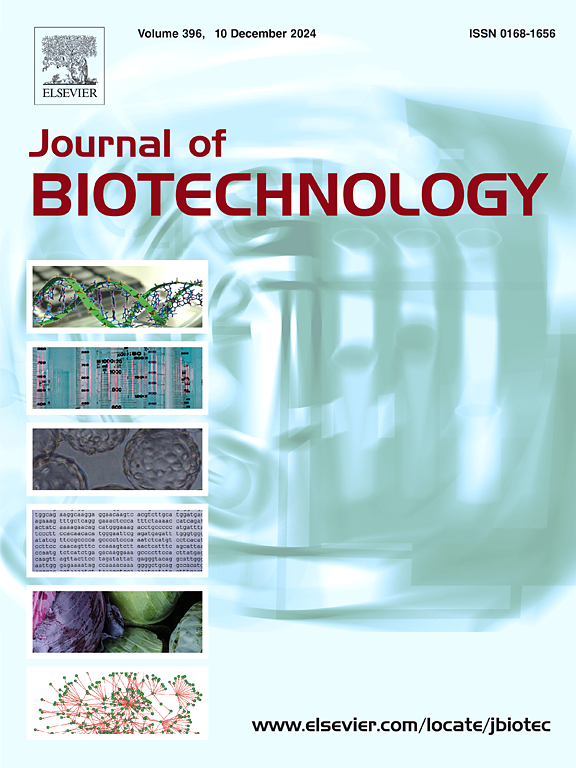高度优化crispr介导的转录抑制的下一代平台。
IF 3.9
2区 生物学
Q2 BIOTECHNOLOGY & APPLIED MICROBIOLOGY
引用次数: 0
摘要
CRISPR干扰(CRISPRi)是转录抑制域与核酸酶无活性Cas9的融合,是一种强大的基因工具,可实现位点特异性基因表达抑制。然而,其性能在不同细胞系、基因靶点或单导rna (sgRNAs)中仍然不一致。本研究通过多管齐下的蛋白质工程方法描述了一种新型的、高度优化的用于哺乳动物基因调控的CRISPRi抑制因子的开发过程:(1)截断已建立的结构域,(2)表征候选结构域,(3)创建组合结构域融合文库,(4)优化NLS配置。首先,通过评估MeCP2的几个截断,我们发现超紧凑的NCoR/SMRT相互作用域(NID)显著增强了CRISPRi基因的敲低性能,比典型MeCP2亚域平均高出约40%。将这种优化的MeCP2 NID截断与多种已验证的阻遏子域结合起来,我们接下来组装和筛选组合多域文库,发现了四种新的阻遏子融合。通过后续的核定位信号(NLS)构型分析,我们发现,固定一个羧基末端的NLS可使阻遏物的基因敲除效率平均提高约50%。通过在多个细胞系、多个sgRNA靶点和全基因组辍学筛选中对nls标记的阻遏物融合物进行严格验证,我们建立了我们最强的系统dCas9-ZIM3-NID-MXD1-NLS,比其他CRISPRi平台实现了优越的基因沉默能力。除了开发dCas9-ZIM3-NID-MXD1-NLS(一种独特有效的转录抑制因子)外,我们设想本研究中使用的多域工程方法将成为有价值的框架,使CRISPR平台的未来发展取得进展。本文章由计算机程序翻译,如有差异,请以英文原文为准。
A next-generation platform for highly optimized CRISPR-mediated transcriptional repression
CRISPR interference (CRISPRi), the fusion of transcriptional repressor domains to nuclease-inactive Cas9, is a powerful genetic tool enabling site-specific suppression of gene expression. However, its performance remains inconsistent across cell lines, gene targets, or single guide RNAs (sgRNAs) employed. This study described the development process of a novel, highly optimized CRISPRi repressor for mammalian gene regulation through a multi-pronged protein engineering approach: (1) truncating established domains, (2) characterizing candidate domains, (3) creating combinatorial domain fusion libraries, and (4) optimizing NLS configuration. First, by evaluating several truncations of MeCP2, a well-established repressor, we see that the ultra-compact NCoR/SMRT interaction domain (NID) significantly enhances CRISPRi gene knockdown performance, exceeding levels observed with canonical MeCP2 subdomains by an average of ∼40 %. Incorporating this optimized MeCP2 NID truncation with a diverse panel of authenticated repressor domains, we next assemble and screen combinatorial multi-domain libraries, discovering four new repressor fusions. Upon follow-up nuclear localization signal (NLS) configuration analysis, we see that affixing one carboxy-terminal NLS enhances gene knockdown efficiency of the repressors by an average of ∼50 %. Through rigorous validation of NLS-tagged repressor fusions across several cell lines, multiple sgRNA targets, and genome-wide dropout screens, we establish that our strongest system, dCas9-ZIM3-NID-MXD1-NLS, achieves superior gene silencing capabilities over alternative CRISPRi platforms. In addition to developing dCas9-ZIM3-NID-MXD1-NLS, a uniquely potent transcriptional repressor, we envision that the multi-domain engineering approach utilized in this study will be valuable framework enabling future strides in CRISPR platform development.
求助全文
通过发布文献求助,成功后即可免费获取论文全文。
去求助
来源期刊

Journal of biotechnology
工程技术-生物工程与应用微生物
CiteScore
8.90
自引率
2.40%
发文量
190
审稿时长
45 days
期刊介绍:
The Journal of Biotechnology has an open access mirror journal, the Journal of Biotechnology: X, sharing the same aims and scope, editorial team, submission system and rigorous peer review.
The Journal provides a medium for the rapid publication of both full-length articles and short communications on novel and innovative aspects of biotechnology. The Journal will accept papers ranging from genetic or molecular biological positions to those covering biochemical, chemical or bioprocess engineering aspects as well as computer application of new software concepts, provided that in each case the material is directly relevant to biotechnological systems. Papers presenting information of a multidisciplinary nature that would not be suitable for publication in a journal devoted to a single discipline, are particularly welcome.
 求助内容:
求助内容: 应助结果提醒方式:
应助结果提醒方式:


